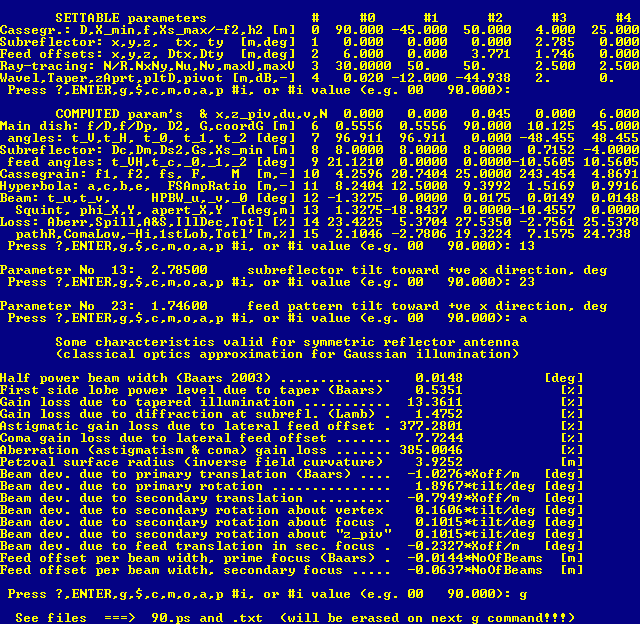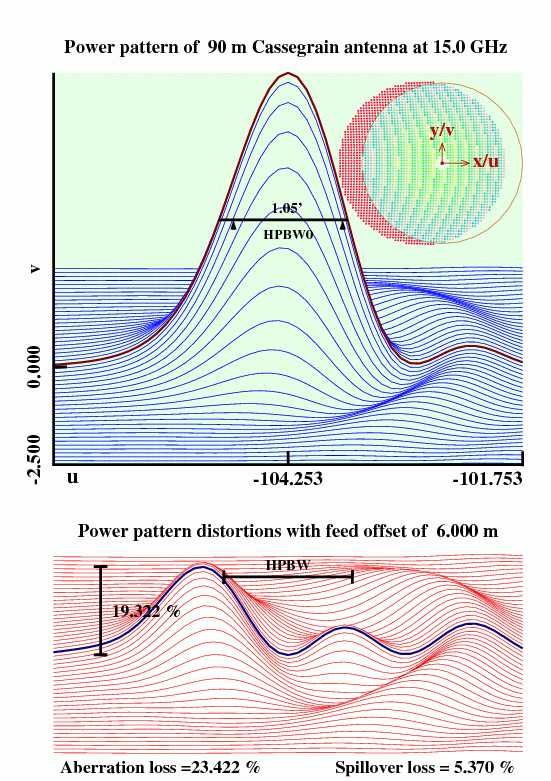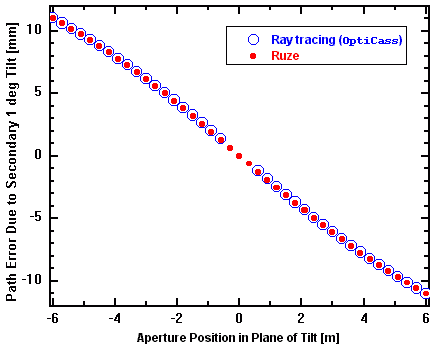OCRA Workshop, Toruń, 3 - 5 Sep 2009
K.M. Borkowski, TCfA
A 90 m Transit Radio Telescope:
Offset or Symmetrical?
The Tool –
OptiCass program
Developed at Centre for Radio Astronomy
Language: Fortran (about 3000 lines)
Method: ray tracing (up to 15 000 rays)
Doesn't use paraxial technique — its ray tracing is exact
DFT of amplitude & phase on aperture –> power pattern
Optimizes through iterations for minimum losses
Input: 25 design and computation parameters
Output: 55 numerical results
18 analytical results
graphical presentation
Example of usage (symmetrical 90 m RT):

Note: As seen in the above screen capture, analytical expressions
of classical optics give completely wrong result (a few hundred percent)
for 'Astigmatic gain loss' due to the assumed very large feed offset (6 m).
It signifies just the fact that classical optics expressions are valid
for small offsets only.
Graphical output (of the above example):

Notes:
1. There are about 2800 rays traced (coloured dots in
the inset at top-right).
2. The value of u = (D/λ)sinΘx = –104.253 corresponds to
Θx = –1.33° main beam shift.
3. The plot of distortions is the difference between the pattern shown
and one computed for feed in the focus.
Reliability of OptiCass
Early
tests have demonstrated that:
For small offsets ray tracing outputs are in very good agreement
with closed formulas results (closed formulas are also built-in in OptiCass);
see this table.
The path length errors in aperture distribution resulting from subreflector tilt
computed for the ALMA 12 m telescope using OptiCass and the J. Ruze's approximate
formulas compare very nicely:

More recently:
When the OCRA-p system has been moved 72 cm away from the focus
in late August 2009, OptiCass predicted about right improvement
in aperture efficiency due to z-offset (towards the subreflector).
RT90 Symmetrical vs Offset
Circular aperture diameter, D 90.000 m
Focal length of primary mirror, f 50.000 m
Frequency, ν 15.0 GHz
Height of secondary focus above paraboloid vertex, h 25.000 m
Primary dish type Symmetrical Offset paraboloid
Primary physical size 90 m 90x102 m
Secondary diameter(s) 8 m 7.4x9.1 m
Secondary projected size 8 m 7.4x8.3 m
Secondary subtended angle 21.1 deg 16x18 deg
Telescope magnification 4.87 5.65
Effective focal length 243 m 283 m
Feed offset in y [m] 1 6 1 6
Optimal z [m] 0.04 3.63 0.02 3.35
Secondary tilt y/(x) [deg] 1.28 3.14 1.96/0.03 3.0/-4.2
Beem offset [deg] 0.10 1.28 0.03 1.12
Minimized gain loss [%] 0.31 20.9 3.80 13.0
NOTES:
1. The x offset is towards the main dish; y – perpendicularly to it.
2. The high losses are mainly due to aberration (phase errors).
3. For offset paraboloid the horizontal (in y) feed displacements
cause both 'vertical' and horizontal beam offsets (see OptiCass graph).
4. At the feed horizontal displacement of 7 m the losses for
offset paraboloid can be reduced to about 17 % and then
the horizontal beam offset would reach 1.33°.
|
The beam throw of an offset telescope
with the main dish built on the same paraboloid of revolution is comparable
to a symmetrical telescope of the same projected diameter.
At larger feed
displacements the offset telescope performs somewhat better (has smaller losses).
A transit 90-m offset telescope with f = 50 m
would allow for about ±5 minutes (±1.25°) of observing time at
the equator with losses not much greater than 13 %.
This would require
somewhat more than ±6 m feed lateral movement accompanied by corresponding
secondary tilts exceeding ±3 and ±4° in two directions (or rather,
alternatively, in one direction with the feed being displaced
also in x direction)
. |
[Last updated: September 7, 2009]


